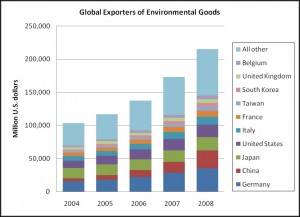 A new article in Fortune Magazine cites the report “Rising Tigers, Sleeping Giant,” which was co-authored by LeadEnergy staff, and emphasizes the need for greater federal investment in clean energy R&D and education programs:
A new article in Fortune Magazine cites the report “Rising Tigers, Sleeping Giant,” which was co-authored by LeadEnergy staff, and emphasizes the need for greater federal investment in clean energy R&D and education programs:
(Fortune Magazine) — Quick: which nation builds the most wind turbines? If you guessed America, with its blustery Great Plains dotted with whirring GE blades, you’d be wrong. In 2009, China became the planet’s largest producer.
What’s going on here? While America was digging itself out of its financial crisis, China quietly positioned itself to become a leader in what promises to be the largest emerging industry of the 21st century: green tech.
A new report by the Breakthrough Institute, a progressive think tank in Oakland, argues that China, along with Japan and Korea, will dominate the clean-energy race by out-investing America.
Asia’s clean-tech tigers are already launching massive government investment programs to dominate this industry and, according to the report, have surpassed the U.S. in virtually all clean-energy areas, including wind, solar, and electric-car batteries.
America, however, shouldn’t despair. But, says Alan Salzman, CEO of Vantage Point Venture Partners, a Silicon Valley VC firm, “We must ensure that our industrial policy — including laws, regulations, access to capital, and incentives — enables the big industries of the 21st century. It should not,” he continues, “preserve and entrench 19th-century ways of generating electricity, powering transportation, and consuming our natural resources.”
And those changes can’t come too soon.
How to become clean-tech competitivePrime the pump
Washington should boost investment. Yes, Obama has agreed to spend $80 billion of the stimulus package on things green, but that pales next to the $217 billion the Chinese government plans to dole out over the next five years. Some experts are now calling for the feds to pump another $15 billion a year into basic research for solar, clean coal, and alternative fuels.Retrain engineers
BYD, an electric-car company in China (Warren Buffett is an investor), has 10,000 engineers working on, among other things, making affordable batteries. With Detroit downsizing, the U.S. has plenty of engineers, but many need to be brought up to speed. One promising sign: A growing number of schools, including Purdue and Colorado State, are offering graduate-level degrees in electric energy systems.Slash red tape
China just launched its GreenGen project, a $1 billion super-efficient coal plant that emits less greenhouse gas than traditional ones. America’s Duke Energy (DUK, Fortune 500) signed a pact with the utility building GreenGen to share clean-coal technology. Why? Because of bureaucratic delays it could take eight years to build such a plant in the U.S. — vs. three in China.


 In an important development within the federal energy and climate policy debate, Bill Gates and Senator Bingaman have spoken out in support of Secretary Chu’s push for major increases in clean energy R&D.
In an important development within the federal energy and climate policy debate, Bill Gates and Senator Bingaman have spoken out in support of Secretary Chu’s push for major increases in clean energy R&D.  A major report
A major report 
 Writing in Foreign Policy magazine, Ted Nordhaus and Michael Shellenberger
Writing in Foreign Policy magazine, Ted Nordhaus and Michael Shellenberger